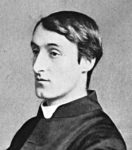
Gerard Manley Hopkins
This poem, a celebration of ‘pied’ things – that is, things made up of two or more different colours – was written in 1877 by Gerard Manley Hopkins (1844-1899). Hopkins was an English poet and Jesuit priest, considered by many to be one of the greatest poets of the Victorian era. He was the oldest of nine children, born into an Anglican family which encouraged his artistic talents. He won a poetry prize as a schoolboy and went on to study the classics at Balliol College in Oxford. In 1866, in the prevailing atmosphere of interest in the relationship between Anglicanism and Roman Catholicism, he was received into the Roman Catholic Church by John Henry (later Cardinal) Newman. Hopkins entered the Jesuit novitiate in 1868, determined to become a priest, and also determined to give up writing poetry. However, he kept a journal recording his vivid responses to nature, encouraged by his studies of Duns Scotus, the medieval Franciscan thinker. In 1874 Hopkins went to St. Beuno’s College in North Wales to study theology. There he learned Welsh, and, under the impact and beauty of the language itself, he began to write poetry again. Ordained to the priesthood in 1877, Hopkins served as a priest in various Jesuit churches and institutions in London, Oxford, Liverpool, and Glasgow, and was appointed professor of Greek literature at University College, Dublin, in 1884. While in Dublin, Hopkins developed his talent for musical composition; the little he composed shows the same daring originality as his poetry. His skill in drawing, too, allowed him to illustrate his journals with meticulously observed details of nature. However, while in Dublin his health began to fail due to the poor living conditions and the challenging workload as a priest. He died of typhoid fever at the age of 49 and is buried in Dublin. His work was not published in collected form until 1918, almost thirty years after his death, thanks to the determination and admiration of his friend and fellow poet Robert Bridges. Once published, it influenced and inspired many leading 20th-century poets, such T.S. Eliot, Dylan Thomas and W.H. Auden.
One of Victorian poet Gerard Manley Hopkins’ best-known poems Pied Beauty rejoices in the multi-coloured peculiarities of nature, which perfectly reflect God’s creativity. Whether it’s the stippled markings of trout, or the contrast of hues in a sunset, this beautiful depiction of ‘couple-colours’ reveals much to celebrate in the world around us. Continue reading →








